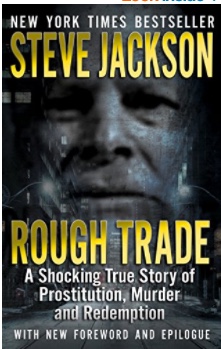
Hmmm. Where to start with this one? I’ve often thought that, contrary to traditional theories, you frequently CAN tell a book by its cover – not so for Rough Trade by Steve Jackson. A close-up of the face of the creepy perv – I mean bad guy – shown above dominates the cover along with the lurid subtitle: “ A shocking true story of prostitution, murder and redemption.” Frankly, its appearance is that of a trashy story that was rushed into print for maximum shock value. And that was totally not the case with the copy of this title that I received from Wild Blue Press and NetGalley in exchange for my honest review.
Jackson includes an extensive foreword that provides insight into what makes him a different true-crime author. He tells us “It’s not the blood and gore, or sexual titillation, I’m looking for…I’m interested in the psychology and “ripple effect” of violent crime, and the back stories of the human beings involved: killers, victims, law enforcement, those involved in the justice system, and the community.” He establishes that the story of the murder of Anita Jones by itself was not enough to build a story around: “her short sad life could not carry a book.” But a fellow prostitute named Joanne Cordova, who had known Anita briefly, was “the flawed heroine seeking redemption.” Joanne Cordova was a former police officer whose life went to hell as she became a crack addict in Denver, during which time she encountered Robert Riggan, the murderer, and subsequently made the difficult choice to do the right thing and work with the police in search of justice for Anita. She did this even though it meant she would be labeled a snitch, thereby putting her own life in danger. (After all, she knew from personal experience as a police officer that “snitches end up in ditches.”)
Then there is the creepy perv – I mean murderer. Robert Riggan “was no Ted Bundy, whose good looks, charming ways and evil cunning has enthralled true crime readers through multiple books.” He was just a “scared, psychologically stunted” man whose horrific crime seemed all too common. It wasn’t until the story of his childhood emerged that the reader learns the reason for him becoming the person he was. As Jackson notes, “sometimes the monsters in our real-life nightmares are created in the homes and by the people who are supposed to represent safety to a child.” Riggan endured rape, incest and horrific abuse growing up. As a former foster parent who has seen and heard the horrors that are all too common for many children, this was heartbreaking. Jackson presents the details in a straightforward way, never sensationalizing them, yet painting a complete picture of the abuse that contributed to Riggan becoming a monster.
The discovery of Anita’s body was serendipitous. It was only because a young couple driving to work in the mountains of Colorado just happened to catch a glimpse of what looked like a man dragging a body up a secluded trail as they drove past. They had a hard time believing what they were seeing, which turned out to be Riggan, who was leaving behind a bloody, dying Anita Jones. He fled the scene as they stopped, but their information and Joanne Cordova’s subsequent efforts resulted in his arrest and conviction.
The story of the crime and its aftermath includes the details of how Joanne Cordova’s choices took her from her life as an outstanding police officer to become a crack-addicted streetwalker. As part of her life on the streets of Denver, she had herself submitted to violent sex with Riggan in exchange for drugs. When she became aware that her friend Anita had been murdered by that same guy, she had a terrible choice to make. Rather than opt to look the other way, keeping herself safe (which would result in Anita’s killer being free to continue his violent attacks on women), she realized that despite all her mistakes in life, “it is never too late to do the right thing.” As she endured the humiliating, detailed exploration of her life during Riggan’s trial, she coped as she had learned to do, by putting on a virtual mask. Rather than crack, her mask was now held in place partly by “the pot and alcohol,” and despite the grueling odeal she went on to find her own personal redemption.
This isn’t great literature, nor is it intended to be. But it is well-written and researched, and includes an important message about the possible results of childhood abuse and bad choices. In addition, it reminds us of the redemption that can occur when someone does the right thing. Five stars (again, it isn’t 5-star “literature,” but it is definitely 5-star true crime).

Pingback: A Clockwork Murder by Steve Jackson | Littoral Librarian: Blogging for Books